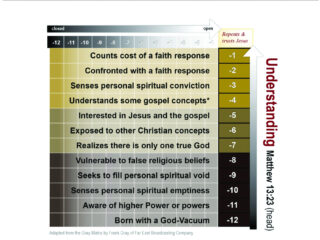Gospel Receptivity – From Closed to Open

A lot of people who understand the gospel of Jesus Christ are not receptive to it—not open to embracing it. And many who do not understand the gospel clearly are very receptive to it—are eager to know more, with an openness to possibly embracing it.
Only God knows the human heart. But if we had a “tool” to help us assess where an unbeliever is in his or her receptivity to the gospel, as well as understanding of it, that could be a very valuable instrument to use in personal evangelism. The Good Soil Evangelism and Discipleship Scale was created to be that kind of tool.
The Good Soil Scale is two-dimensional. The vertical dimension addresses understanding. The horizontal dimension addresses receptivity.

Gospel Understanding – The Vertical Dimension
In the first article of this series, we learned that the parable of the soils is recorded three times in the gospels. In order to understand what and who a “good soil” gospel recipient is, we need to understand the distinct meanings of three key Greek verbs that appear in those verses:
Matthew 13:23 – One who Understands…
Mark 4:20 – One who Accepts…
Luke 8:15 – One who Holds on to the gospel.
In the second article of the series, we looked at an overview of the Good Soil Evangelism and Discipleship Scale, with a focus on the vertical or “understanding” dimension of the scale, particularly the lower half of the scale. We are all born with a God-Vacuum (-12) and move up the scale as we are exposed to truths about the God of the Bible and His plan for our redemption through His Son, Jesus Christ. This vertical (understanding) dimension of the scale is related to Matthew 13:23:
“As for what was sown on good soil, this is the one who hears the word and understands it. He indeed bears fruit and yields, in one case a hundredfold, in another sixty, and in another thirty.”

Gospel Receptivity – The Horizontal Dimension
But Mark, the gospel writer, used a completely different Greek word to describe a good soil recipient:
Mark 4:20 – “But those that were sown on the good soil are the ones who hear the word and accept it and bear fruit, thirtyfold and sixtyfold and a hundredfold.”
People do not become genuine Christians by only understanding the gospel; they must also embrace it with their hearts. And before unbelievers come to the point of embracing, when exposed to the gospel, they vary in their degrees of receptivity toward the message of God’s provision for their salvation.
Assessing an unbeliever’s receptivity to the gospel is even more subjective and difficult to know than assessing and knowing his or her understanding of the gospel. Consequently, assigning a specific receptivity number is not possible, nor necessary. The idea of the horizontal-receptivity dimension is simply to help us to assess generally how open or how closed an unbeliever friend probably is to the good news of God’s salvation.
Often it is the nonverbal cues that are just as much as, or even more so, revealing as the verbal statements made during gospel-focused conversations. Whether it be from verbal or non-verbal cues, it is usually easy to get a general sense of gospel-openness or gospel-rejection.
The keys to helping an unbeliever move from being closed to the gospel to being open to the gospel sound very simple, maybe even simplistic. But in actual practice they can be very difficult for most of us who understand the ultimate consequences of their rejection of our Savior.
1. Love them unconditionally.
2. Model Christlikeness consistently.
3. Pray for them persistently.
4. Watch opportunistically for natural “entry points” to share a gospel truth.
5. Be patient optimistically! Wait for God to work in their hearts to draw them to Himself.

The Understanding-Receptivity Matrix
A vertical dimension and a horizontal dimension create a matrix.
Think of this—every unbeliever in the world is somewhere in this matrix! But only God knows where for sure.
Every unbeliever is somewhere on the vertical (understanding) scale. And he or she is also somewhere on the horizontal (receptivity) scale. And although we, as personal evangelists, do not know where they for-sure are on either scale, it is helpful for us to have a general sense of our unbelieving friend’s understanding of and receptivity to the gospel. Accessing an unbeliever’s gospel receptivity and understanding is important because it helps us know how and how fast to proceed with him or her in evangelism.
Think of someone you know who is, to your knowledge, not a true believer in Jesus Christ—not born again. Where do you think this person is in his or her gospel understanding? In his or her Gospel receptivity? If you know the person fairly well, you can probably even focus on a spot in the matrix where this person is vertically and horizontally.
Previous articles in this series:
Three Greek Verbs Define Good Soil
Assessing Unbeliever’s Gospel Understanding
Attend a Good Soil Evangelism and Discipleship Seminar
Read more about Good Soil Evangelism and Discipleship



